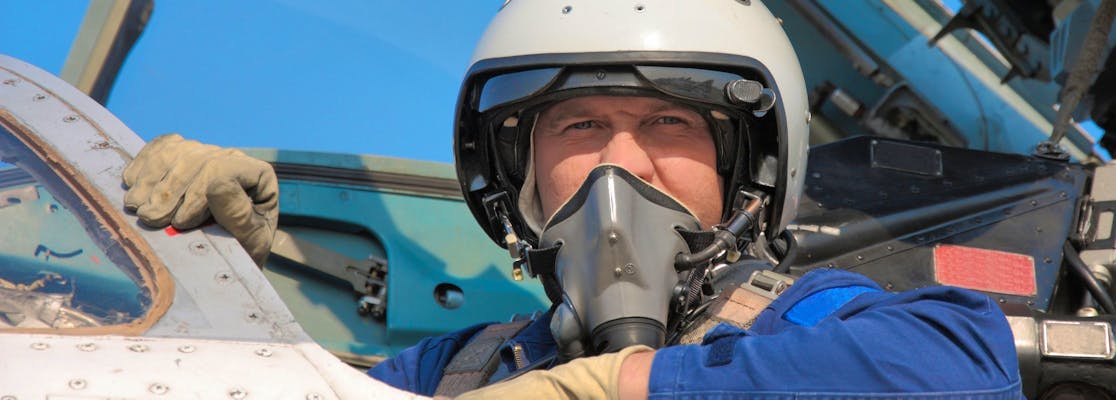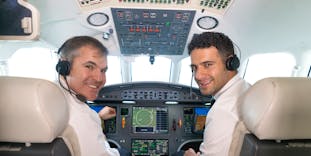How to Pass the RAF Aptitude Test in 2026
Updated November 5, 2024
- What Is the RAF Aptitude Test and What Is Its Purpose?
- RAF CBAT vs RAF AST
- RAF Aptitude Test Format
- RAF Aptitude Test - Verbal Reasoning
empty
- RAF Aptitude Test - Numerical Skills
empty
- RAF Aptitude Test - Work Rate
empty
empty
- RAF Aptitude Test - Spatial Reasoning
empty
empty
- RAF Aptitude Test - Electrical Comprehension
empty
- RAF Aptitude Test - Mechanical Reasoning
empty
- RAF Aptitude Test - Memory
empty
- What to Expect When Taking the RAF Aptitude Test in 2025
- How to Get a Good Score on the RAF Aptitude Test in 2026
- RAF Aptitude Test Scoring and Results
- RAF Aptitude Test - What’s Next?
empty
empty
empty
empty
- Frequently Asked Questions
- Conclusion
What Is the RAF Aptitude Test and What Is Its Purpose?
The RAF Aptitude Test, or Airmen Selection Test (AST) as it is often known, is a bespoke aptitude test designed to assess new recruits applying for the Royal Airforce.
The test comprises questions from seven aptitude tests, all of which are featured in more detail in this article.
If you’re applying for a non-commissioned personnel role like Airman, Airwoman, Air Traffic Controller/Officer, Weapons Systems Operator or Aerospace Battle Manager, you will have to sit this test.
However, the purpose of the test is to assess your abilities in different areas and identify the roles you would be strongest in – even if you don’t know it yet.
The RAF has a huge workforce with many different job roles; you might think you know the trade you want to pursue in the forces, but the aptitude test is designed to give you some other options so that you can make the best decision based on your personal strengths.
A lot rests on this test, so performing well is crucial.
How well you do in the test will largely determine your future career. Your results will influence whether you can do the trade you set out to do, and where you will be allocated for your placement.
RAF CBAT vs RAF AST
There are two types of tests for RAF applicants. Which one you take will depend on the position you are applying for.
Non-commissioned personnel will take the AST, whereas commissioned roles – like pilots or intelligence officers – will take the CBAT.
Here are the main differences between the two:
| RAF CBAT | RAF AST |
|---|---|
| Taken at RAF College Cranwell, Lincolnshire, UK only | The test is taken at your nearest armed forces career office (AFCO) |
| Comprises 15 or more tests depending on the role you are applying for (which trade). Heavy emphasis on assessing your natural ability in different areas – like short term memory and mental math. | Comprises seven different aptitude tests: Verbal Reasoning, Numerical Reasoning, Spatial Reasoning, Electrical Comprehension, Work Rate, Memory, and Mechanical Reasoning |
RAF Aptitude Test Format
There are a total of 148 questions split over seven categories. You will have 90 minutes to complete as much of the test as you can; you will not lose marks for wrong answers.
If you don’t understand something, feel unwell or need assistance of any kind, attract the attention of the test administrator by raising your hand.
The seven different parts of the test are:
- Verbal reasoning
- Numerical skills
- Work rate
- Spatial reasoning
- Electrical comprehension
- Mechanical reasoning
- Memory
RAF Aptitude Test - Verbal Reasoning
The Verbal Reasoning part of the AST comprises 20 questions.
These usually start with passages of text, followed by questions on what you have read.
The Verbal Reasoning section is assessing your English comprehension skills and your ability to reason when the problem is presented as text (rather than numerically or visually).
Example Verbal Reasoning Question
High-visibility jackets are bright outer garments used to alert people to the wearer’s presence. This is either to protect the wearer of the high vis, or the people in the vicinity of that person. High-vis jackets are often worn in the workplace by those putting themselves or others in danger, such as highways maintenance personnel, parking attendants and construction workers. In some instances, people also wear high-vis jackets in their leisure time, for example, horse riders, cyclists and runners.
Highways maintenance personnel are required to wear high-vis jackets
Is this statement:
- True
- False
- Cannot say
Practice RAF Test with JobTestPrep
RAF Aptitude Test - Numerical Skills
The Numerical Skills section includes basic arithmetic (12 questions) and data interpretation (15 questions).
You will have four minutes to complete the first section and 11 minutes to complete the second section. You will be provided with a pen and paper.
Your workings will have to be handed in at the end of the test, but they won’t influence your marks in any way.
Example Numerical Skills Question
A man earns a monthly salary of £2,450; his monthly outgoings are £1,200. How many months would it take him to be able to buy a motorbike costing £3,400?
A. 2 months
B. 3 months
C. 6 months
D. 4 months
RAF Aptitude Test - Work Rate
Work rate questions ask candidates to find the rate of work using information that is usually missing key details.
Some work rate questions are quite straightforward, whilst others test your arithmetic knowledge.
Here are two examples of the types of work rate questions you might be given in your AST. One straightforward question, and one more difficult question that you would only be able to answer if you knew how to multiply fractions and had a basic grasp of algebra.
Example Straightforward Work Rate Question
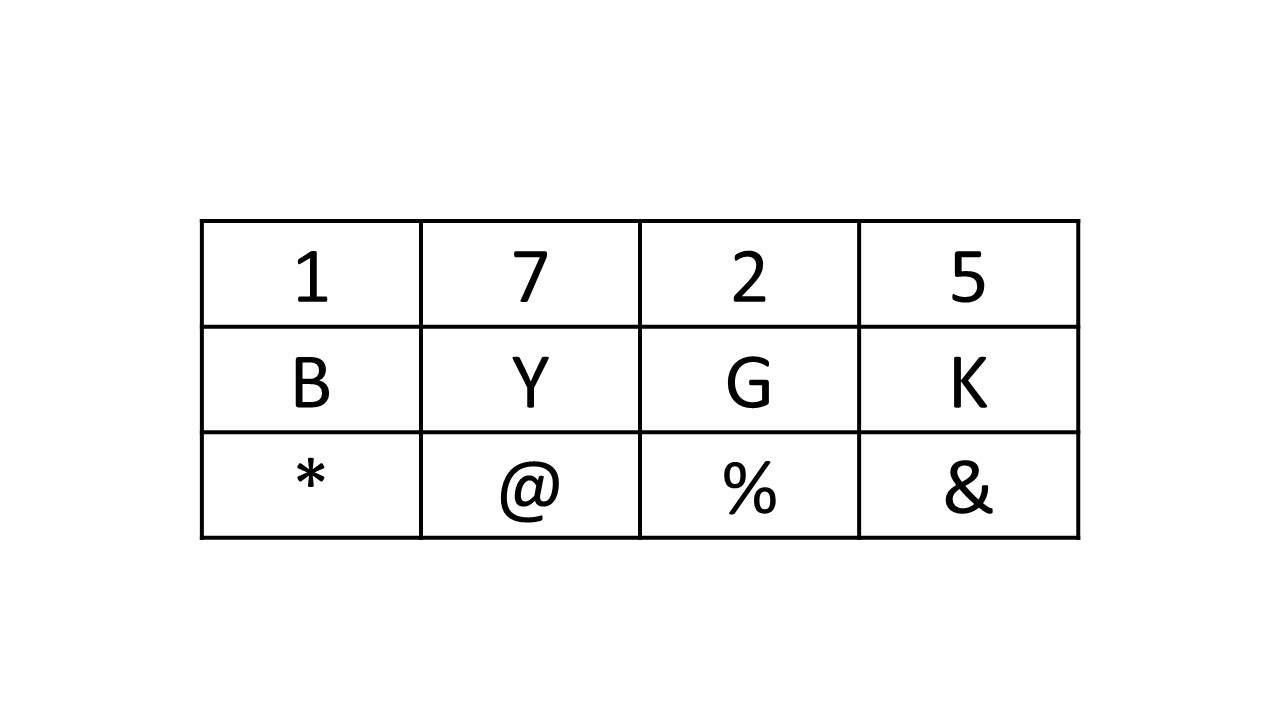
Which could be a possible code for 752?
A. @&*
B. YGB
C. Y&B
D. YKG
It takes four hours for Pump A to fill a swimming pool with water. Pump B used alone takes six hours to fill the same swimming pool. I want to use three pumps; A, B and a third, Pump C, to fill the tank in one hour.
What would be the rate of Pump C? How long would it take Pump C alone to fill the tank?
RAF Aptitude Test - Spatial Reasoning
Spatial reasoning tests your 2D and 3D orientation skills. In the first part of the test, four minutes are allocated for the 10 questions on 2D orientation, reconstructing broken shapes into whole pieces.
The second part of the test features 3D shapes viewed from different angles.
The questions include having to decide which of the shapes remain unchanged in their structure despite looking different due to the angle and selecting the correct 3D shape for a particular net. For this part of the test, you are given three minutes.
Example 2D Shapes Question
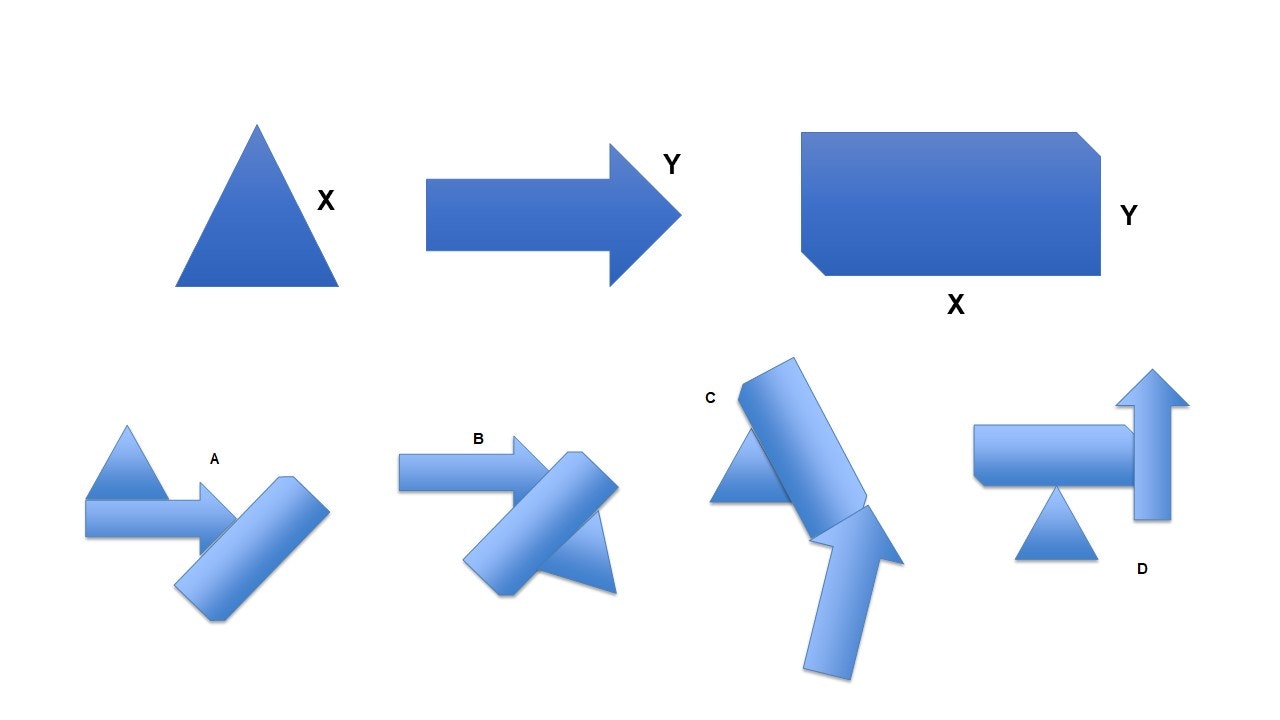
Which answer option is created by joining the corresponding letters together using all of the three shapes above?
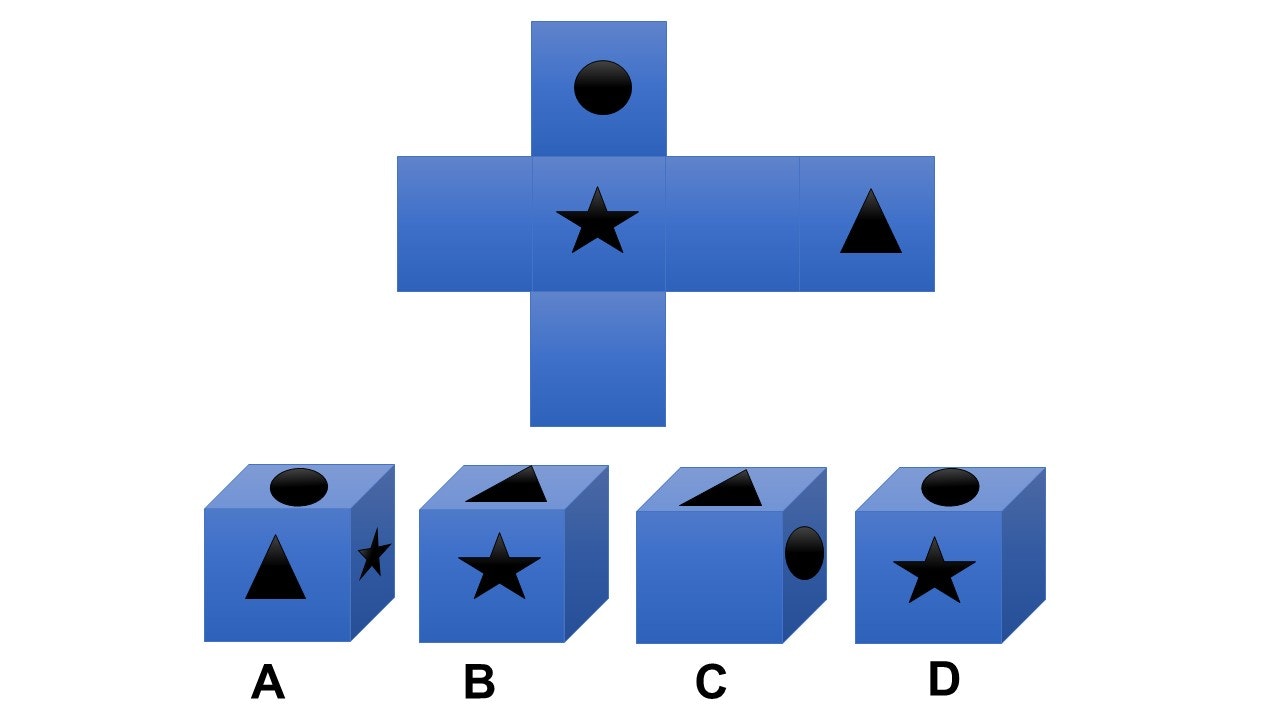
Which 3D shape can be made from the 2D net?
RAF Aptitude Test - Electrical Comprehension
There are 21 questions in this section and you have 11 minutes to answer them.
The questions are the same difficulty level as you would find at GCSE level, so to be in with a good chance of answering the questions, revise GCSE physics concepts.
Example Electrical Comprehension Question
Which list correctly describes the three basic particles that make up an atom?
A. Neutrons, protons and electrons
B. Particles, protons and neutrons
C. Mesons, protons and neutrons
D. Particles, mesons and protons
If you need to prepare for a number of different employment tests and want to outsmart the competition, choose a Premium Membership from JobTestPrep.
You will get access to three PrepPacks of your choice, from a database that covers all the major test providers and employers and tailored profession packs.
This is a good example of a question to which you either know the answer or not. If you don’t know it, take a guess and move on quickly.
RAF Aptitude Test - Mechanical Reasoning
Like Electrical Comprehension, the Mechanical Reasoning section is also based on GCSE-level physics questions. These 20 questions cover topics like forces, levers and pulleys, motion, etc. and you have 10 minutes to answer them.
Example Mechanical Reasoning Question

Which load is the heaviest?
A. Load A
B. Load B
C. Both the same
RAF Aptitude Test - Memory
This section is in two parts. For the first part, you will be shown a sequence of letters (one at a time), usually via a screen in the examination room. Once you can no longer see them, you will be asked questions about them.
Example Memory Question
Study the letter sequence below:
A d Y U h n w
Once you can no longer see the sequence, you may be asked questions like:
- How many letters are there between Y and n?
- How many capital letters are there?
In the second part of the memory section, you will be shown a series of grids with yellow dots in them (one at a time).
Once you can no longer see them, you will be shown more complicated grids, and then asked to identify which one represents the combination of dots in the original grid sequence.
What to Expect When Taking the RAF Aptitude Test in 2025
You should dress smartly for your test; it is suggested that women wear low heels. There are strictly no T-shirts, sportswear, trainers or jeans.
On the day of your test, you will have an introductory meeting with your recruiter who will tell you what to expect and go through the necessary paperwork with you.
Remember to bring photo ID (driving licence or passport), otherwise you will not be able to sit the AST that day.
The test will be taken under exam conditions, invigilated by RAF career officers. Other people will be taking the test at the same time at different tables.
You don’t need to bring anything into the test with you – only glasses if you require them for reading or looking at a screen.
It is important not to spend too long on each question and get through as much of the test as you can in the time allowed. According to the RAF, most people run out of time and do not complete all the questions.
How to Get a Good Score on the RAF Aptitude Test in 2026
As with any aptitude assessment, the best possible thing you can do in preparation for your test is to practise.
Practising will get you used to the style of questions, how to answer them, the format and the time constraints.
Here are some other tips for getting a great score on your AST:
Step 1. Control Your Nerves
It’s important to work on controlling your nerves in the lead up to the test.
This aptitude test requires you to be at your most alert and focused. Nerves get in the way of concentration and lose you valuable minutes.
One of the best ways to combat nerves is to do as many practice papers as possible, so that on the day of your test, the types of questions and format of the paper is familiar to you and doesn’t seem daunting.
Step 2. Make Sure You Are Not Rushed Getting to Your AFCO
Leave plenty of time, taking traffic and late trains/buses into consideration. You need to avoid becoming flustered and give yourself ample time to gather your thoughts and composure before the test.
Step 3. Revise Your Basic Knowledge
This is not a test in which you will be able to do well without prior preparation.
Although the majority of the test is assessing your natural reasoning ability, that natural ability can be vastly improved with practice.
There are also questions for which you will need to know:
- Basic arithmetic – Adding, subtracting, and multiplication and division of whole numbers, percentages and fractions.
- Basic English – Spelling and grammar.
- Basic physics – Laws of physics and basic electrical and mechanical knowledge (circuits, levers and pulleys, etc.)
Step 4. Take Practice Tests
Make sure you complete as many practice questions as possible and read supporting materials on websites, YouTube videos and blogs to ensure you have everything covered.
Step 5. Consider Professional Coaching
Invest in your future by organising coaching and professional help.
So much rides on this test, it’s worth paying for extra support to give yourself the very best chance of doing well.
Step 6. Research Test Techniques and Tips
As you practise and read up on the individual tests, you will pick up techniques and tips for approaching questions. Try to revise these techniques so that you can apply them to the questions.
Step 7. Don’t Linger on Questions
If you are struggling, take a guess (you don’t get penalised for wrong answers) and move on.
Step 8. Breathe
If you feel like you are reading but not processing the information, sit back from the paper, take a few deep breaths and try again.
Step 9. Get Friends and Relatives to Test You
Read an article in the newspaper and ask them to question you on its content once you are no longer looking at it. You could also ask them to quiz you on the contents of graphs and tables so that you can improve your speed at reaching an answer.
Step 10. Learn to Visualise Shapes
Have a go at trying to picture shapes in different positions so that you improve your ability to visualise them.
You could also practise memorising sequences of numbers, letters, shapes or pictures.
RAF Aptitude Test Scoring and Results
Once your test finishes, you can leave the test room and AFCO and take a break before coming back to hear your results.
You won’t be given a test result in the form of a mark. The point of this test is to assess your ability in different areas and see which roles you would be best suited to.
Despite not being given a score in the form of a percentage, your test is still scored in two parts.
- There are specific scores for each of the seven sections – for each test you will awarded a score of between 1 and 9.
- There are six group scores where you can achieve a raw score of up to 100; the group scores are referred to as A, B, C, D and E.
Pass marks will vary according to the trade you have applied for, and are likely to be higher for roles that are in demand.
The RAF doesn’t reveal what these pass marks are, so you don’t know what you’re aiming for – you just have to do the very best you can.
After your paper has been marked, you will be called in for ‘trade counselling’ with your recruiter. This meeting is designed to work out which trade path you should take, based on the results of your assessment.
You might be surprised by the trades that are suggested. You will be able to discuss the individual trades with your recruiter to learn more about them if you don’t know the details already.
If you have scored highly, you will be able to pick from a selection of suggested trades. If you get a lower score than you had hoped for, your recruiter may offer you a selection of other career paths that don’t require such high scores. Either way, you will be invited back to attend an interview (not on the same day).
If you fail the AST, you can retake the test. However, if you fail a second time it may be years before you can retake the test.
RAF Aptitude Test - What’s Next?
If you achieved a high enough pass to be able to do the original job you applied for, or even if you would like to pursue a different trade, you will go from your trade counselling session to watch a presentation by one of the recruiters.
This presentation will provide you with more information about military life and prepare you for the next steps of the selection process, including how to prepare for your interview.
Take a pen and paper to this presentation so that you can take notes – these notes will be crucial when preparing for your interview.
Selection Interview
The selection interview will take place at your AFCO and will be led by your recruiter.
Over the course of 30–45 minutes, you will be asked about your hobbies, education, family, work experience, achievements and why you want to join the RAF.
Use this interview as a chance to show the recruiter that you possess the qualities the RAF looks for; like teamwork, confidence and leadership.
You need to demonstrate an excellent knowledge of the RAF and the job you have applied for (where you might be posted, what training is involved). You will also be asked about your interest in joining, so you need to have answers prepared.
Questions you might be asked include:
- Which parts of basic training do you think you might struggle with?
- Tell me about why you want to join the Royal Airforce and not the Army or the Navy?
- In your opinion, what are the positives and negatives about joining the armed forces?
Fitness Test
If all goes well with your interview, you will be invited to a health assessment and will be asked to complete a fitness test.
The fitness test features several different tests of your strength and agility, including running 2.4 km, press-ups and sit-ups. Time limits for each part of the test are based on age and gender.
The RAF website features a free, 12-week training plan which is great for making sure your fitness levels are high enough to be able to pass this test. There are also video demos of exercises and advice on eating well.
Pre-Recruit Training
If you successfully complete the fitness test to RAF standard, you will undertake pre-recruit training over three days at RAF Halton.
This is designed to introduce you to what RAF basic recruit training is like.
During the three days, you will be required to take another fitness test, and potentially a functional skills test in English and maths – depending on the position you have applied for.
Provisional Offer of Service Interview
If you successfully complete all these steps, you will be invited to a Provisional Offer of Service interview.
This interview is designed to ensure that you are fully aware of what you have signed up for and understand the level of commitment you will need to show.
The interview also gives you a chance to ask any questions you still have.
The RAF Airman (or Airwoman) Selection Test is an aptitude assessment that is designed to evaluate new recruits who have applied for non-commissioned roles in the RAF.
As an aptitude test, no previous knowledge of the role is needed or assumed – the test is looking at specific attributes to see what roles or trades within the RAF would most suit the abilities of each recruit.
The RAF aptitude test is split into seven different categories, and you will have 90 minutes to answer 148 questions in total. Each category is looking at a different skill, as follows:
- Verbal reasoning – Read, understand and analyze data in the form of written information and use it to make logical and reasoned decisions.
- Numerical skills – Basic arithmetic and understanding of different mathematical concepts
- Work rate – How quickly and accurately you can complete tasks
- Spatial reasoning – the ability to be able to visualize objects in space and manipulate them in different ways
- Electrical comprehension – Basic understanding of electrical principles and recognition of circuits etc
- Mechanical reasoning – Understand and analyze mechanical diagrams and make logical and reasoned decisions based on physics principles
- Memory – Recalling information from a previous screen accurately and quickly.
If you are looking for resources designed to get you the best score in the RAF aptitude test, then there are several places online that can be effective.
The RAF Careers site has a wealth of information available – not only about the tests but also about what you can expect through training and things that you might need to consider before applying.
For free practice tests and helpful knowledge, the resources at JobTestPrep are thorough and easy to understand – and for the best results, you can invest in a Prep Pack which has even more tests, revision guides, and tips to help you perform at your best on the day.
In terms of books, one of the most popular selections is the How2Become RAF Airman Tests which has different practice tests inside.
The more you practice and prepare, the higher your score will be in the assessment, and the more doors will open for you in terms of trades and roles in the RAF.
Preparation is key for superior performance in the RAF aptitude test, and one of the best ways you can prepare is through practice.
Facing a test is a nerve-wracking situation, and not knowing what to expect can make it even more of a challenge. Through practice tests that are based on the real thing, you will be able to get familiar with the structure and layout of the assessment as well as the type of questions that are being asked.
When you are practicing the assessment, try and make it as realistic as possible. Set yourself up with exam conditions in a quiet place where you won’t be disturbed. Be sure to use a timer – the real test has a 90-minute time limit and you will need to answer 148 questions, so you need to work quickly.
Aptitudes are inherent skills, but they can be improved with practice – and you can give yourself the best chance by revising basic (school level) principles of maths, English and science. Read widely and get used to thinking about the way different information is being provided, brush up on basic arithmetic and mental maths, and make sure you are aware of the various physics principles that govern mechanics and electricity.
As you approach the test day, make sure you are focusing on giving your brain the nutrition it needs to perform to the highest standard. One of the most important things that you can do is get a good amount of sleep in the days before the test and focus on healthy and filling meals with plenty of hydration.
On the day, make sure you turn up to the test center on time – and aim for early. You don’t want to be rushing at the beginning of the day because that will put you under unnecessary pressure. Be sure to be well presented and smartly dressed, as this will help you feel confident.
If you are looking for the best practice RAF aptitude test questions and answers, then you will find an excellent resource on the RAF Careers site, with a PDF booklet containing basic information about what to expect and a practice test.
If you want more practice and lots of information about the RAF aptitude test including revision material and tips and tricks for success, then JobTestPrep has resources that are free alongside a paid-for Prep Pack that will definitely improve your chances of getting selected for your ideal trade.
There are several things that you can do to pass the RAF aptitude test, but it all comes down to how you perform on the day.
Practice tests and revision of various principles that underpin skills in reading, maths and physics will make a dramatic difference to how comfortable you are in answering the questions and make you more familiar with the structure and layout of the assessment itself.
Ensuring that you are mentally and physically healthy through good sleep and excellent nutrition and hydration will give you the best chance to perform at your best on the day.
The scoring for the RAF aptitude test is slightly different from other pre-employment screening tests in that each section is scored between 1 and 9, and then there are group scores A to E. The score you need to achieve to get the role or trade that you are most interested in is not published, so it is best to aim for the best score possible as this is what will open the doors you need for the trade you want.
After the assessment, you will take part in ‘trade counseling’ where a recruitment officer will discuss your results and what they show in terms of the right role to suit your natural aptitude and skills, and you can discuss the next steps.
While flight simulation is an important part of pilot training, for the RAF aptitude test, you will not need any previous knowledge or experience of flying.
This means that using a DCS with a joystick as practice will not help you perform better on the RAF aptitude test.
With this being said, however, previous recruits have found it useful to practice for any flight simulations assessments using a DCS and a joystick, so it might be helpful later in the training process.
To become a fighter pilot with the RAF, you will have to take and pass the RAF CBAT, which is an aptitude test designed for recruits who have applied for commissioned roles.
Unlike the AST, the CBAT has a high cut-off point for consideration for a commissioned role, and the only way to get through to initial training is to achieve at least the minimum required score. This means that if you do not pass the test, you will not be considered for a role as a pilot.
You can retake the test if the Recruitment Officer recommends it, but you can only retake once (you will have to wait several years for another chance if you fail it again).
The RAF aptitude test is designed to be challenging, even though the content taken in isolation is not hard. As an assessment, it is used to evaluate potential recruits on their natural abilities and aptitudes so that they can be matched to the right role or trade.
The structure of the assessment as well as the exam conditions and time limit are what makes the RAF aptitude hard in most cases. Unfamiliarity, nerves and working under pressure combine to put a candidate through their paces and demonstrate what their potential is.
Getting a pass in the RAF aptitude test will be used to decide if you have the basic competencies to be successful in the future, while the exact score you achieve will determine what trades or roles for which you can train.
The pressure of the exam scenario and the unfamiliarity of the question content can be mitigated through practice tests, and you can hone your aptitudes by revising basic principles of maths, English and science.
Although the marks in the RAF aptitude tests needed for recruits to be considered for various non-commissioned and commissioned roles are not published, to give yourself the best chance of success you need to score as highly as possible.
There is a minimum achievement score needed to progress, and if you do not meet this then you will have failed the RAF aptitude test.
However, this does not have to be the end of the story. If the recruitment officer agrees, you can take the test one more time – and you may be able to retake if you didn’t quite make the grade for the trade or role you set your sights on.
The RAF interview and assessment should be considered a formal event and you should dress appropriately.
In most cases, this means a suit with a shirt and tie or similar, with clean polished low-heeled shoes.
You need to be comfortable enough to give your best but look the part in terms of presentation. Neat, clean and pressed – you want to come across as poised, presentable and confident throughout the application process.
The RAF selection process does not have a standard timeline – different roles require different pre-employment processes so they can take longer or shorter.
In most cases, you can expect it to take anywhere between three to nine months from initial application to starting basic training.
Once you have completed the 90-minute RAF aptitude test, you will be invited to take a short break while your assessment is marked.
You will then take part in trade counseling where your Recruitment Officer will discuss your score as it relates to the trades or roles for which you have qualified. You might not learn what your score is as a number, but you will get an opportunity to discuss the next steps.
If you did not achieve the score you needed for the trade you were interested in, or you failed the RAF aptitude test, your Recruitment Officer might suggest a retake.
After this, you can expect to take part in a selection interview, followed by a medical assessment and a fitness test.
When you start basic training with the RAF, you get paid a competitive salary from the beginning. Thanks to the residential nature of the training, you will have limited expenses and bills so this pay leaves you with more money in your pocket.
As a rule, new recruits undertaking training can expect a salary ranging from £16,235 to £39,000 (depending on role) alongside other benefits and access to discounts.
The minimum requirement to join the RAF is at least three GCSEs at grades 9 to 4, including English and maths (as well as science in some cases).
There are equivalent qualifications that will be considered, but the best bet is to speak to a Recruitment Officer to check other eligibility requirements.
To be an RAF pilot, you need to meet minimum eyesight requirements.
This means that in almost all cases, you will not be able to become a pilot with the RAF if you need to wear glasses or corrective lenses. This is just one of the medical conditions that preclude entry.
You may be allowed to become part of the aircrew with glasses, but this is not guaranteed and you should discuss it with a Recruitment Officer at your local AFCO.
There are several medical conditions that might mean you are not able to join the RAF, and any current psychiatric illness is one of them.
If you have suffered any depressive disorders, with or without treatment, in the last three years then you will not be allowed to join the RAF.
If you want some clarification, then speak with the Recruitment Officer at your local AFCO – although they are not medically trained, they will be able to seek the right information for you.
In some cases, RAF pilots do carry guns.
This is especially true in wartime, but throughout history, fighter pilots tend to rely on the weaponry attached to their jets.
If you have had asthma in the past, you will not be able to fly but you might be able to join the ground crew to serve – even if you have no symptoms and are not currently medicated. This will be assessed on a case-by-case basis.
If you have current symptoms of asthma or an active prescription for an inhaler, you are ineligible to apply for the RAF.
For more information, you can check out the medical preclusion list that the RAF has created.
If you have low-level and high functioning Asperger’s syndrome, you might be considered for a trade in the RAF, but it would have to be assessed on a case-by-case basis and might affect the roles for which you can apply.
There is more information available on the RAF Careers site.
RAF pilots can expect an average minimum salary of £30,000 in the first year plus benefits, rising to an average of £42,000 and benefits following completion of specialist training.
The salary of a pilot will increase through the length of service and if the pilot gets promoted.
Conclusion
The key to success in the AST is practice and revision.
Practice will help you get used to the format of the test and the style of questions, and revision will ensure you know all of those basic maths, English and physics principles you probably never thought you’d need again.
Use online resources like GCSE Bitesize and the RAF’s dedicated AST pages.
Getting a great pass on your AST will set you up for a rewarding career in the RAF. It is worth putting in the extra hours, and even extra money in the form of a coach, to ensure you give yourself the very best chance of securing a fantastic role.
